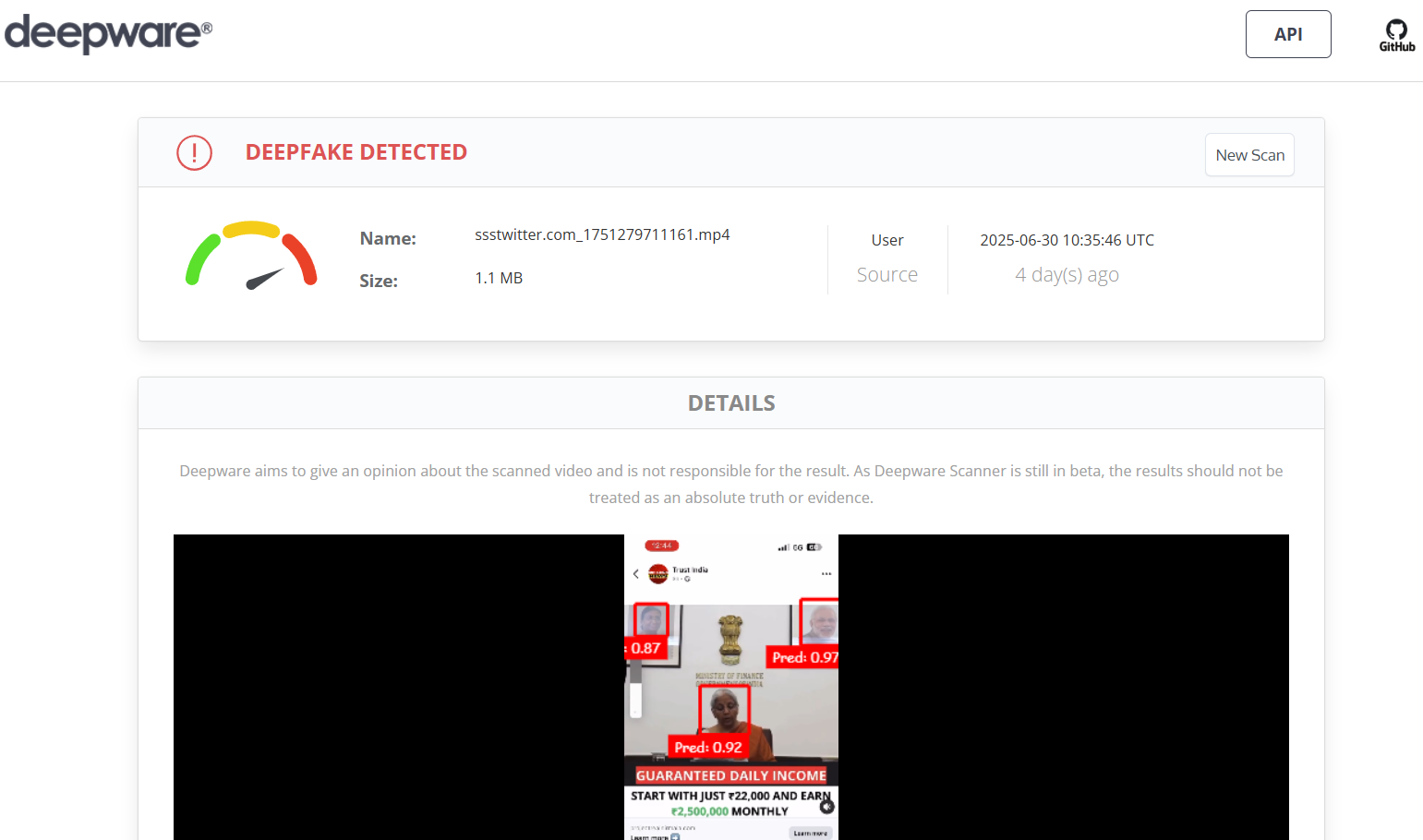#FactCheck - Stunning 'Mount Kailash' Video Exposed as AI-Generated Illusion!
EXECUTIVE SUMMARY:
A viral video is surfacing claiming to capture an aerial view of Mount Kailash that has breathtaking scenery apparently providing a rare real-life shot of Tibet's sacred mountain. Its authenticity was investigated, and authenticity versus digitally manipulative features were analyzed.
CLAIMS:
The viral video claims to reveal the real aerial shot of Mount Kailash, as if exposing us to the natural beauty of such a hallowed mountain. The video was circulated widely in social media, with users crediting it to be the actual footage of Mount Kailash.


FACTS:
The viral video that was circulated through social media was not real footage of Mount Kailash. The reverse image search revealed that it is an AI-generated video created by Sonam and Namgyal, two Tibet based graphic artists on Midjourney. The advanced digital techniques used helped to provide a realistic lifelike scene in the video.
No media or geographical source has reported or published the video as authentic footage of Mount Kailash. Besides, several visual aspects, including lighting and environmental features, indicate that it is computer-generated.
For further verification, we used Hive Moderation, a deep fake detection tool to conclude whether the video is AI-Generated or Real. It was found to be AI generated.

CONCLUSION:
The viral video claiming to show an aerial view of Mount Kailash is an AI-manipulated creation, not authentic footage of the sacred mountain. This incident highlights the growing influence of AI and CGI in creating realistic but misleading content, emphasizing the need for viewers to verify such visuals through trusted sources before sharing.
- Claim: Digitally Morphed Video of Mt. Kailash, Showcasing Stunning White Clouds
- Claimed On: X (Formerly Known As Twitter), Instagram
- Fact Check: AI-Generated (Checked using Hive Moderation).
Related Blogs

Executive Summary:
A video circulating on social media falsely claims that India’s Finance Minister, Smt. Nirmala Sitharaman, has endorsed an investment platform promising unusually high returns. Upon investigation, it was confirmed that the video is a deepfake—digitally manipulated using artificial intelligence. The Finance Minister has made no such endorsement through any official platform. This incident highlights a concerning trend of scammers using AI-generated videos to create misleading and seemingly legitimate advertisements to deceive the public.

Claim:
A viral video falsely claims that the Finance Minister of India Smt. Nirmala Sitharaman is endorsing an investment platform, promoting it as a secure and highly profitable scheme for Indian citizens. The video alleges that individuals can start with an investment of ₹22,000 and earn up to ₹25 lakh per month as guaranteed daily income.

Fact check:
By doing a reverse image search from the key frames of the viral fake video we found an original YouTube clip of the Finance Minister of India delivering a speech on the webinar regarding 'Regulatory, Investment and EODB reforms'. Upon further research we have not found anything related to the viral investment scheme in the whole video.
The manipulated video has had an AI-generated voice/audio and scripted text injected into it to make it appear as if she has approved an investment platform.

The key to deepfakes is that they seem relatively realistic in their facial movement; however, if you look closely, you can see that there are mismatched lip-syncing and visual transitions that are out of the ordinary, and the results prove our point.


Also, there doesn't appear to be any acknowledgment of any such endorsement from a legitimate government website or a credible news outlet. This video is a fabricated piece of misinformation to attempt to scam the viewers by leveraging the image of a trusted public figure.
Conclusion:
The viral video showing the Finance Minister of India, Smt. Nirmala Sitharaman promoting an investment platform is fake and AI-generated. This is a clear case of deepfake misuse aimed at misleading the public and luring individuals into fraudulent schemes. Citizens are advised to exercise caution, verify any such claims through official government channels, and refrain from clicking on unknown investment links circulating on social media.
- Claim: Nirmala Sitharaman promoted an investment app in a viral video.
- Claimed On: Social Media
- Fact Check: False and Misleading
.webp)
Introduction
The AI Action Summit is a global forum that brings together world leaders, policymakers, technology experts, and industry representatives to discuss AI governance, ethics, and its role in society. This year, the week-long Paris AI Action Summit officially culminated on the 11th of February, 2025. It brought together experts from the industry, policymakers, and other dignitaries to discuss Artificial Intelligence and its challenges. The event was co-chaired by Indian Prime Minister Narendra Modi and French President Emmanuel Macron. In line with the summit, the Indian delegation actively engaged in the 2nd India-France AI Policy Roundtable, an official side event of the summit, and the 14th India-France CEOs Forum. These discussions were on diverse sectors including defense, aerospace, technology, etc. among other things.
Prime Minister Modi’s Address
During the AI Action Summit in Paris, Prime Minister Narendra Modi drew attention to the revolutionary effect of AI in politics, the economy, security, and society. Stressing the requirement of international cooperation, he promoted strong frameworks of governance to combat AI-based risks and consequently, build public confidence in new technologies. Needed efforts with respect to cybersecurity issues such as deepfakes and disinformation were also acknowledged.
Democratising AI, and sharing its benefits, particularly with the Global South not only aligned with Sustainable Development Goals (SDGs) but also affirmed India’s resolve towards sharing expertise and best practices. India’s remarkable feat of creating a Digital Public Infrastructure, that caters to a population of 1.4 billion through open and accessible technology was highlighted as well.
Among the key announcements, India revealed its plans to create its own Large Language Model (LLM) that reflects the country's linguistic diversity, strengthening its AI aspirations. Further, India will be hosting the next AI Action Summit, reaffirming its position in international AI leadership. The Prime Minister also welcomed France's initiatives, such as the launch of the "AI Foundation" and the "Council for Sustainable AI", initiated by President Emmanuel Macron. He emphasized the necessity to extend the Global Partnership for AI and to get it more representative and inclusive so that Global South voices are actually incorporated into AI innovation and governance.
Other Perspectives
Though there were 58 countries that signed the international agreement on a more open, inclusive, sustainable, and ethical approach to AI development (including India, France, and China), the UK and the US have refused to sign the international agreement at the AI Summit stating their issues with global governance and national security. While the former raised concerns about the lack of sufficient details regarding the establishment of global AI governance and AI’s effect on national security as their reason, the latter showcased its reservations about the overly wide AI regulations which had the potential to hamper a transformative industry. Meanwhile, the US is also looking forward to ‘Stargate’, its $500 billion AI infrastructure project alongside the companies- OpenAI, Softbank, and Oracle.
CyberPeace Insights
The Summit has garnered greater significance with the backdrop of the release of platforms such as DeepSeek R1, China’s AI assistant system similar to that of OpenAI’s ChatGPT. On its release, it was the top-rated free application on Apple’s app store and sent the technology stocks tumbling. Moreover, investors world over appreciated the creation of the model which was made roughly in about $5 million while other AI companies spent more in comparison (keeping in mind the restrictions caused by the chip export controls in China). This breakthrough challenges the conventional notion that massive funding is a prerequisite for innovation, offering hope for India’s burgeoning AI ecosystem. With the IndiaAI mission and fewer geopolitical restrictions, India stands at a pivotal moment to drive responsible AI advancements.
References:
- https://www.mea.gov.in/press-releases.htm?dtl/39023/Prime_Minister_cochairs_AI_Action_Summit_in_Paris_February_11_2025
- https://indianexpress.com/article/explained/explained-sci-tech/what-is-stargate-trumps-500-billion-ai-project-9793165/
- https://pib.gov.in/PressReleasePage.aspx?PRID=2102056
- https://pib.gov.in/PressReleasePage.aspx?PRID=2101947
- https://pib.gov.in/PressReleasePage.aspx?PRID=2101896
- https://www.timesnownews.com/technology-science/uk-and-us-decline-to-sign-global-ai-agreement-at-paris-ai-action-summit-here-is-why-article-118164497
- https://www.thehindu.com/sci-tech/technology/india-57-others-sign-paris-joint-statement-on-inclusive-sustainable-ai/article69207937.ece
.webp)
Introduction
Big Tech has been pushing back against regulatory measures, particularly regarding data handling practices. X Corp (formerly Twitter) has taken a prominent stance in India. The platform has filed a petition against the Central and State governments, challenging content-blocking orders and opposing the Center’s newly launched Sahyog portal. The X Corp has furthermore labelled the Sahyog Portal as a 'censorship portal' that enables government agencies to issue blocking orders using a standardized template.
The key regulations governing the tech space in India include the IT Act of 2000, IT Rules 2021 and 2023 (which stress platform accountability and content moderation), and the DPDP Act 2023, which intersects with personal data governance. This petition by the X Corp raises concerns for digital freedom, platform accountability, and the evolving regulatory frameworks in India.
Elon Musk vs Indian Government: Key Issues at Stake
The 2021 IT Rules, particularly Rule 3(1)(d) of Part II, outline intermediaries' obligations regarding ‘Content Takedowns’. Intermediaries must remove or disable access to unlawful content within 36 hours of receiving a court order or government notification. Notably, the rules do not require government takedown requests to be explicitly in writing, raising concerns about potential misuse.
X’s petition also focuses on the Sahyog Portal, a government-run platform that allows various agencies and state police to request content removal directly. They contend that the failure to comply with such orders can expose intermediaries' officers to prosecution. This has sparked controversy, with platforms like Elon Musk’s X arguing that such provisions grant the government excessive control, potentially undermining free speech and fostering undue censorship.
The broader implications include geopolitical tensions, potential business risks for big tech companies, and significant effects on India's digital economy, user engagement, and platform governance. Balancing regulatory compliance with digital rights remains a crucial challenge in this evolving landscape.
The Global Context: Lessons from Other Jurisdictions
The ‘EU's Digital Services Act’ establishes a baseline 'notice and takedown' system. According to the Act, hosting providers, including online platforms, must enable third parties to notify them of illegal content, which they must promptly remove to retain their hosting defence. The DSA also mandates expedited removal processes for notifications from trusted flaggers, user suspension for those with frequent violations, and enhanced protections for minors. Additionally, hosting providers have to adhere to specific content removal obligations, including the elimination of terrorist content within one hour and deploying technology to detect known or new CSAM material and remove it.
In contrast to the EU, the US First Amendment protects speech from state interference but does not extend to private entities. Dominant digital platforms, however, significantly influence discourse by moderating content, shaping narratives, and controlling advertising markets. This dual role creates tension as these platforms balance free speech, platform safety, and profitability.
India has adopted a model closer to the EU's approach, emphasizing content moderation to curb misinformation, false narratives, and harmful content. Drawing from the EU's framework, India could establish third-party notification mechanisms, enforce clear content takedown guidelines, and implement detection measures for harmful content like terrorist material and CSAM within defined timelines. This would balance content regulation with platform accountability while aligning with global best practices.
Key Concerns and Policy Debates
As the issue stands, the main concerns that arise are:
- The need for transparency in government orders for takedowns, the reasons and a clear framework for why they are needed and the guidelines for doing so.
- The need for balancing digital freedom with national security and the concerns that arise out of it for tech companies. Essentially, the role platforms play in safeguarding the democratic values enshrined in the Constitution of India.
- This court ruling by the Karnataka HC will have the potential to redefine the principles upon which the intermediary guidelines function under the Indian laws.
Potential Outcomes and the Way Forward
While we wait for the Hon’ble Court’s directives and orders in response to the filed suit, while the court's decision could favour either side or lead to a negotiated resolution, the broader takeaway is the necessity of collaborative policymaking that balances governmental oversight with platform accountability. This debate underscores the pressing need for a structured and transparent regulatory framework for content moderation. Additionally, this case also highlights the importance of due process in content regulation and the need for legal clarity for tech companies operating in India. Ultimately, a consultative and principles-based approach will be key to ensuring a fair and open digital ecosystem.
References
- https://www.thehindu.com/sci-tech/technology/elon-musks-x-sues-union-government-over-alleged-censorship-and-it-act-violations/article69352961.ece
- https://www.hindustantimes.com/india-news/elon-musk-s-x-sues-union-government-over-alleged-censorship-and-it-act-violations-101742463516588.html
- https://www.financialexpress.com/life/technology-explainer-why-has-x-accused-govt-of-censorship-3788648/
- https://thelawreporters.com/elon-musk-s-x-sues-indian-government-over-alleged-censorship-and-it-act-violations
- https://www.linklaters.com/en/insights/blogs/digilinks/2023/february/the-eu-digital-services-act---a-new-era-for-online-harms-and-intermediary-liability


